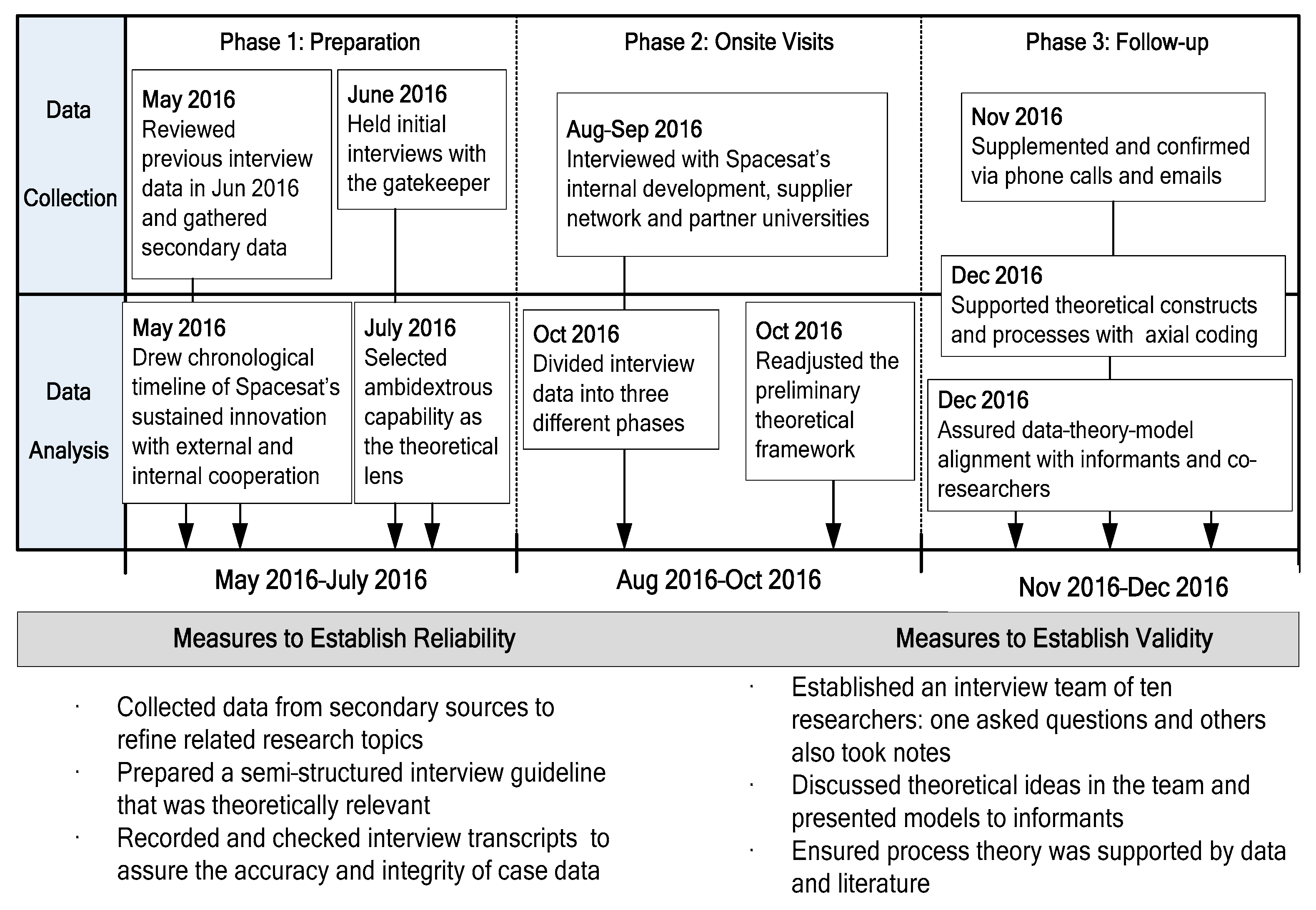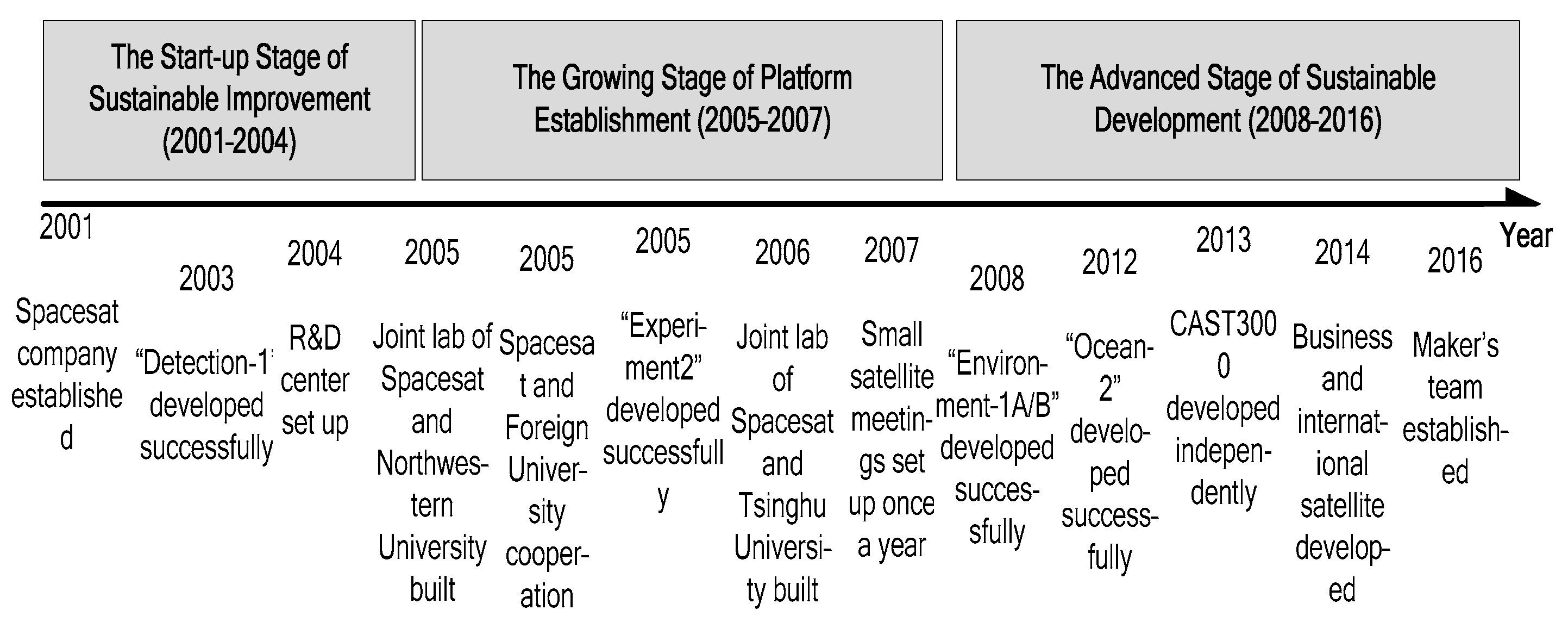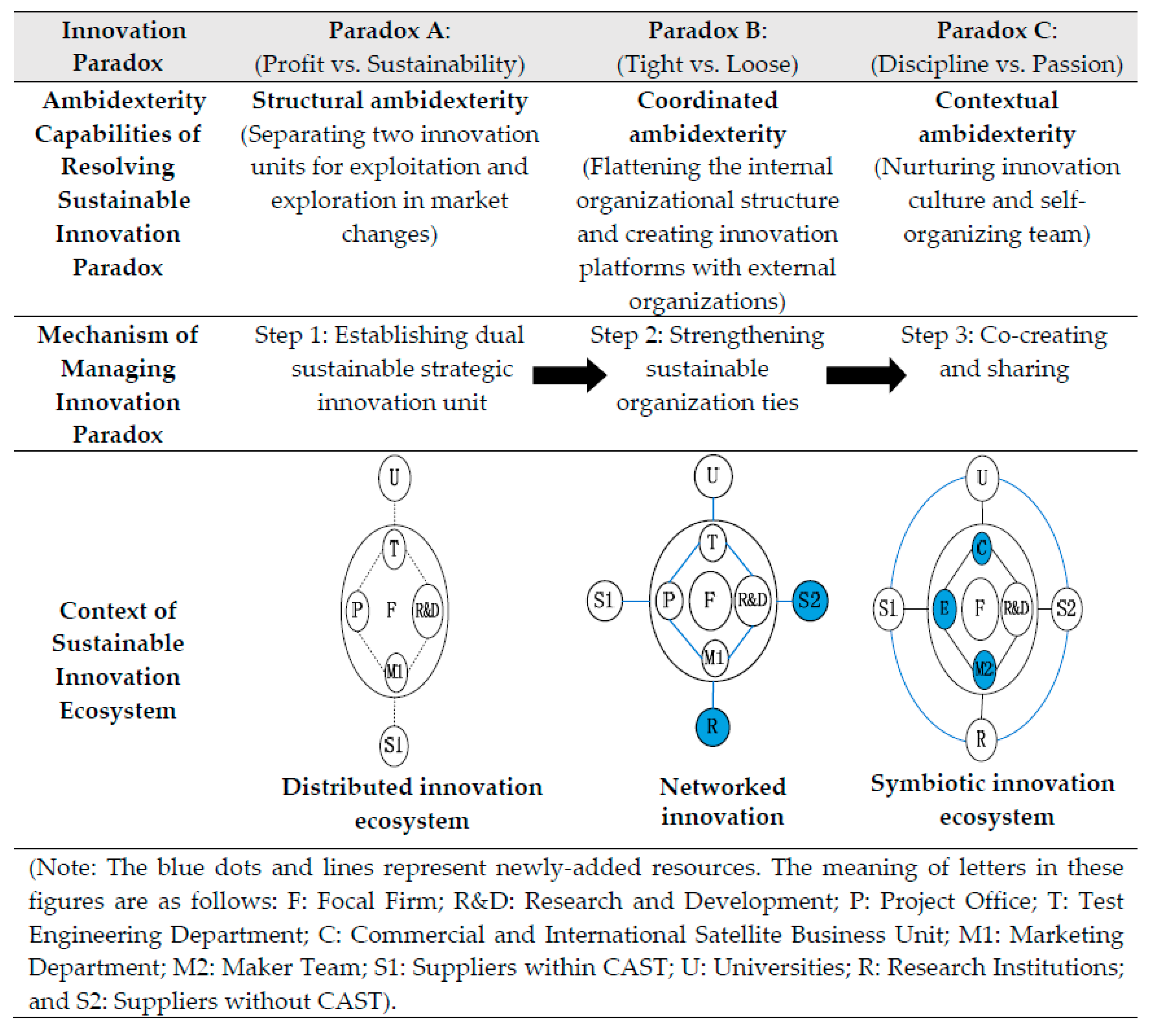Managing Innovation Paradox in the Sustainable Innovation Ecosystem: A Case Study of Ambidextrous Capability in a Focal Firm
Abstract
:1. Introduction
2. Literature Review
2.1. Sustainable Innovation Ecosystem
2.2. Innovation Paradox in Sustainability
2.3. Ambidextrous Capability for Sustainable Innovation
3. Research Method
4. Case Description and Analysis
4.1. Phase 1: Establishing Sustainable Innovation Strategic Logic (Paradox A: Profit Strategy and Sustainability Strategy)
Our company is listed. Product quality should be ensured and production cost should be controlled in the research and development of every satellite. To respond to the market quickly, if a satellite needs to be upgraded or reproduced after its first flight, Spacesat seldom changes the overall design and technologies, including platform technology. This is usually the case at the beginning of Spacesat’s development. But to ensure the leading status in the market of small satellites, Spacesat invests about 10% of its income every year into the research and development of new satellite platforms and payload technologies.—Director of the Spacesat R&D Center
4.2. Phase 2: Framing the Sustainable Innovation Ways (Paradox B: Tight Coupling and Loose Coupling)
Through the intimate cooperation between the internal and external organizations of the firm, we can produce more than 10 small satellites each year and survive in both the domestic and the international markets. This cooperation also pushes forward the continuous development of our sustainable innovation ecology.—General Manager of Spacesat
4.3. Phase 3: Promoting the Sustainable Innovation Drive (Paradox C: Discipline Orientation and Passion Orientation)
Our company requires the R&D and innovation works to “produce technologies and products”. That is, a technology is produced only when it has been used in a practical model and a product is produced only when it takes a flight in the aerospace. This changes R&D staffs’ mindset. Their technological innovation must be sent into space to become models and their performance determined by success. Therefore, I think Spacesat integrates success with innovation very well and this atmosphere indirectly promotes the idea of innovation in the cooperation between the firm and other organizations. After all, in the field of aerospace, success is everything.—Head of Strategic Planning Department
5. Discussion
5.1. Step 1: Establishing Two Sustainable Strategic Innovation Units
We will let the Project Office and R&D Center take the lead. The Project Office assembles departments such as the Systems Engineering Office for production, aiming to improve and import innovations including optical imaging and nuclear magnetism radar imaging in existing and fixed domains. The R&D Center focuses on exploratory tasks such as space exploration and satellite platform technologies.—General Manager Assistant of Spacesat
5.2. Step 2: Strengthening Sustainable Organizational Ties
From the input of creativity to the product end or the output of new technology, small satellite production can be divided into two stages: creative design and model design. The intermediate stage is project approval. Products of every model should be examined and approved by the state control committee. Meanwhile, teams such as the International Satellite Department in the charge of top managers have been built to lead the innovation platforms such as [the] joint lab and industry-university-institute center established by Spacesat and external organizations.—Vice General Manager of Spacesat
5.3. Step 3: Co-Creating and Sharing
“The ‘special innovation zone’, on one hand, makes production partners stay within the red line of our policies, and on the other hand, opens resources in various aspects and resolves the paradox between technology (such as overall delegation, test prioritizing, and joint development) and management (such as material guarantee and personnel assignment). Overall delegation means that we used to put the overall production solution first and then personnel in engineering and other entities start to develop the product, but now we do these two things at the same time. As for the test, we used to make tests after production is accomplished, but now the testing personnel also engage in product design and development.”—Top Manager of R&D Center
6. Conclusions
6.1. Theoretical Contributions
6.2. Managerial Implication
6.3. Limitations and Future Research
Acknowledgments
Author Contributions
Conflicts of Interest
References
- Hsieh, Y.C.; Lin, K.Y.; Lu, C.; Rong, K. Governing a sustainable business ecosystem in Taiwan’s circular economy: The story of spring pool glass. Sustainability 2017, 9, 1068. [Google Scholar] [CrossRef]
- Andriopoulos, C.; Lewis, M.W. Exploitation-exploration tensions and organizational ambidexterity: Managing paradoxes of innovation. Organ. Sci. 2009, 20, 696–717. [Google Scholar] [CrossRef]
- Glavovic, B.C. Coastal innovation paradox. Sustainability 2013, 5, 912–933. [Google Scholar] [CrossRef]
- Spender, J.C.; Spender, J.C.; Corvello, V.; Rippa, P. Startups and open innovation: A review of the literature. Eur. J. Innov. Manag. 2017, 20, 4–30. [Google Scholar] [CrossRef]
- Galati, F.; Bigliardi, B.; Petroni, A. Open innovation in food firms: Implementation strategies, drivers and enabling factors. Int. J. Innov. Manage. 2016, 20, 1650042. [Google Scholar] [CrossRef]
- Calof, J.; Meissner, D.; Razheva, A. Overcoming open innovation challenges: A contribution from foresight and foresight networks. Technol. Anal. Strateg. Manag. 2017. [Google Scholar] [CrossRef]
- Adner, R.; Kapoor, R. Value creation in innovation ecosystems: How the structure of technological interdependence affects firm performance in new technology generations. Strateg. Manag. J. 2010, 31, 306–333. [Google Scholar] [CrossRef]
- Hermann, R.R.; Wigger, K. Eco-innovation drivers in value-creating networks: A case study of ship retrofitting services. Sustainability 2017, 9, 733. [Google Scholar] [CrossRef]
- Gregory, R.W.; Keil, M.; Muntermann, J.; Mähring, M. Paradoxes and the nature of ambidexterity in IT transformation programs. Inf. Syst. Res. 2015, 26, 57–80. [Google Scholar] [CrossRef]
- Hanaki, N.; Owan, H. Autonomy, conformity and organizational learning. Adm. Sci. 2013, 3, 32–52. [Google Scholar] [CrossRef]
- Leten, B.; Vanhaverbeke, W.; Roijakkers, N.; Van Helleputte, J. IP models to orchestrate innovation ecosystems. Calif. Manag. Rev. 2013, 55, 51–64. [Google Scholar] [CrossRef]
- Zhong, J.; Nieminen, M. Resource-based co-innovation through platform ecosystem: Experiences of mobile payment innovation in China. J. Strateg. Manag. 2015, 8, 283–298. [Google Scholar] [CrossRef]
- Hasler, K.; Olfs, H.W.; Omta, O.; Bröring, S. Drivers for the adoption of eco-innovations in the German fertilizer supply chain. Sustainability 2016, 8, 682. [Google Scholar] [CrossRef]
- O’Reilly, C.A.; Tushman, M.L. Organizational ambidexterity: Past, present, and future. Acad. Manag. Perspect. 2013, 27, 324–338. [Google Scholar] [CrossRef]
- Nishida, S.I.; Kawamoto, S.; Okawa, Y.; Kitamura, S. Space debris removal system using a small satellite. Acta Astronaut. 2009, 65, 95–102. [Google Scholar] [CrossRef]
- Chen, Y.S.; Chang, C.H.; Lin, Y.H. The determinants of green radical and incremental innovation performance: Green shared vision, green absorptive capacity, and green organizational ambidexterity. Sustainability 2014, 6, 7787–7806. [Google Scholar] [CrossRef]
- Adner, R.; Kapoor, R. Innovation ecosystems and the pace of substitution: Re-examining technology S-curves. Strateg. Manag. J. 2015, 3, 1–24. [Google Scholar] [CrossRef]
- Kapoor, R.; Lee, J.M. Coordinating and competing in ecosystems: How organizational forms shape new technology investments. Strateg. Manag. J. 2013, 34, 274–296. [Google Scholar] [CrossRef]
- Hansen, E.; Nybakk, E.; Panwar, R. Innovation insights from North American forest sector research: A literature review. Forests 2014, 5, 1341–1355. [Google Scholar] [CrossRef]
- Freeman, C. Technology Policy and Economic Performance; Pinter Publishers: Great Britain, UK, 1989. [Google Scholar]
- Mas-Verdu, F.; Ribeiro Soriano, D.; RoigDobon, S. Regional development and innovation: The role of services. Serv. Ind. J. 2010, 30, 633–641. [Google Scholar] [CrossRef]
- Carayannis, E.G.; Campbell, D.F.J. Mode 3 Knowledge Production in Quadruple Helix Innovation Systems; Springer: New York, NY, USA, 2012. [Google Scholar]
- Wareham, J.; Fox, P.B.; Cano Giner, J.L. Technology ecosystem governance. Organ. Sci. 2014, 25, 1195–1215. [Google Scholar] [CrossRef]
- Schwartz, D.; Bar-EI, R. The role of a local industry association as a catalyst for building an innovation ecosystem: An experiment in the state of ceara in Brazil. Innovation 2015, 17, 383–399. [Google Scholar] [CrossRef]
- Lauritzen, G.D. The role of innovation intermediaries in firm-innovation community collaboration: Navigating the membership paradox. J. Prod. Innov. Manag. 2017, 34, 289–314. [Google Scholar] [CrossRef]
- Teece, D.J. Explicating dynamic capabilities: The nature and micro foundations of (sustainable) enterprise performance. Strateg. Manag. J. 2007, 28, 1319–1350. [Google Scholar] [CrossRef]
- Davila, T.; Epstein, M. The Innovation Paradox: Why Good Businesses Kill Breakthroughs and How They Can Change; Berrett-Koehler Publishers: San Francisco, CA, USA, 2014. [Google Scholar]
- Poole, M.S.; Van de Ven, A.H. Using paradox to build management and organization theories. Acad. Manag. Rev. 1989, 14, 562–578. [Google Scholar]
- Smith, W.K.; Lewis, M.W. Toward a theory of paradox: A dynamic equilibrium model of organizing. Acad. Manag. Rev. 2011, 36, 381–403. [Google Scholar]
- Bogers, M. The open innovation paradox: Knowledge sharing and protection in R&D collaborations. Eur. J. Innov. Manag. 2011, 14, 93–117. [Google Scholar]
- Jay, J. Navigating paradox as a mechanism of change and innovation in hybrid organizations. Acad. Manag. J. 2013, 56, 137–159. [Google Scholar] [CrossRef]
- Chrisman, J.J.; Chua, J.H.; De Massis, A.; Frattini, F.; Wright, M. The ability and willingness paradox in family firm innovation. J. Prod. Innov. Manag. 2015, 32, 310–318. [Google Scholar] [CrossRef]
- Martini, A.; Laugen, B.T.; Gastaldi, L.; Corso, M. Continuous innovation: Towards a paradoxical, ambidextrous combination of exploration and exploitation. Int. J. Technol. Manag. 2013, 61, 1–22. [Google Scholar] [CrossRef]
- Duncan, R.B. The ambidextrous organization: Designing dual structures for innovation. Manag. Organ. Des. 1976, 1, 167–188. [Google Scholar]
- Wan, X.; Cenamor, J.; Parker, G.; Van Alstyne, M. Unraveling Platform Strategies: A Review from an Organizational Ambidexterity Perspective. Sustainability 2017, 9, 734. [Google Scholar] [CrossRef]
- Jansen, J.J.P.; Tempelaar, M.P.; Van den Bosch, F.A.J.; Volberda, H.W. Structural differentiation and ambidexterity: The mediating role of integration mechanisms. Organ. Sci. 2009, 20, 797–811. [Google Scholar] [CrossRef] [Green Version]
- Stettner, U.; Lavie, D. Ambidexterity under scrutiny: Exploration and exploitation via internal organization, alliances, and acquisitions. Strateg. Manag. J. 2015, 35, 1903–1929. [Google Scholar] [CrossRef]
- Eisenhardt, K.M.; Furr, N.R.; Bingham, C.B. Crossroads-Micro foundations of performance: Balancing efficiency and flexibility in dynamic environments. Organ. Sci. 2010, 21, 1263–1273. [Google Scholar] [CrossRef]
- Du, W.; Pan, S.L.; Zuo, M. How to balance sustainability and profitability in technology organizations: An ambidextrous perspective. IEEE Trans. Eng. Manag. 2013, 60, 366–385. [Google Scholar] [CrossRef]
- Dobón, S.R.; Soriano, D.R. Exploring alternative approaches in service industries: The role of entrepreneurship. Serv. Ind. J. 2008, 28, 877–882. [Google Scholar] [CrossRef]
- Gibson, C.B.; Birkinshaw, J. The antecedents, consequences, and mediating role of organizational ambidexterity. Acad. Manag. J. 2004, 47, 209–226. [Google Scholar] [CrossRef]
- Güttel, W.H.; Konlechner, S.W.; Trede, J.K. Standardized Individuality versus Individualized Standardization: The Role of the Context in Structurally Ambidextrous Organizations. Rev. Manag. Sci. 2015, 9, 261–284. [Google Scholar] [CrossRef]
- Tushman, M.L.; O’Reilly, C.A. Ambidextrous organizations: Managing evolutionary and revolutionary change. Calif. Manag. Rev. 1996, 38, 8–30. [Google Scholar] [CrossRef]
- Wei, Z.; Yi, Y.; Guo, H. Organizational learning ambidexterity, strategic flexibility, and new product development. J. Prod. Innov. Manag. 2014, 31, 832–847. [Google Scholar] [CrossRef]
- Yin, R.K. Case Study Research: Design and Methods; Sage Publications: London, UK, 2013. [Google Scholar]
- Pan, S.L.; Tan, B. Demystifying Case Research: A Structured–Pragmatic–Situational (SPS) Approach to Conducting Case Studies. Inf. Organ. 2011, 21, 161–176. [Google Scholar] [CrossRef]
- Eisenhardt, K.M.; Graebner, M.E.; Sonenshein, S. Grand Challenges and Inductive Methods: Rigor without Rigor Mortis. Acad. Manag. J. 2016, 59, 1113–1123. [Google Scholar] [CrossRef]
- Khalfallah, M.; Figay, N.; Da Silva, C.F.; Ghodous, P. A cloud-based platform to ensure interoperability in aerospace industry. J. Intell. Manuf. 2016, 27, 119–129. [Google Scholar] [CrossRef]
- Kleinbaum, A.M.; Stuart, T.E. Inside the black box of the corporate staff: Social networks and the implementation of corporate strategy. Strateg. Manag. J. 2014, 35, 24–47. [Google Scholar] [CrossRef]
- Whealan-George, K.A.; Brady, T.; McAndrew, I.; Price, I.; Clair, R.T. Economic Interrelationships and Impacts of the Aviation/Aerospace Industry in the State of Florida using Input-Output Analysis. Int. J. Aviat. Aeronaut. Aerosp. 2015, 2, 9–29. [Google Scholar]
- Dunne, D.D.; Dougherty, D. Abductive reasoning: How innovators navigate in the labyrinth of complex product innovation. Organ. Stud. 2016, 37, 131–159. [Google Scholar] [CrossRef]
- Wang, Z.; Huang, J.; Tan, B. Managing organizational identity in the e-commerce industry: An ambidexterity perspective. Inf. Manag. 2013, 50, 673–683. [Google Scholar] [CrossRef]
- Raisch, S. Balanced structures: Designing organizations for profitable growth. Long Range Plan. 2008, 41, 483–508. [Google Scholar] [CrossRef]
- Mihalache, O.R.; Jansen, J.J.P.; Van den Bosch, F.A.J.; Volberda, H.W. Top management team shared leadership and organizational ambidexterity: A moderated mediation framework. Strateg. Entrep. J. 2014, 8, 128–148. [Google Scholar] [CrossRef]
- Benavides-Espinosa, M.D.M.; Ribeiro-Soriano, D. Cooperative learning in creating and managing joint ventures. J. Bus. Res. 2014, 67, 648–655. [Google Scholar] [CrossRef]
- Kauppila, O.P.; Tempelaar, M.P. The social-cognitive underpinnings of employees’ ambidextrous behaviour and the supportive role of group managers’ leadership. J. Manag. Stud. 2016, 53, 1019–1044. [Google Scholar] [CrossRef]
- Kiamehr, M.; Hobday, M.; Hamedi, M. Latecomer firm strategies in complex product systems (CoPS): The case of Iran’s thermal electricity generation systems. Res. Policy 2015, 44, 1240–1251. [Google Scholar] [CrossRef]
- Soriano, D.R.; Huarng, K.H. Innovation and entrepreneurship in knowledge industries. J. Bus. Res. 2013, 66, 1964–1969. [Google Scholar] [CrossRef]
- Parellada, F.S.; Soriano, D.R.; Huarng, K.H. An overview of the service industries’ future (priorities: Linking past and future). Serv. Ind. J. 2011, 31, 1–6. [Google Scholar] [CrossRef]



| Research Hotspots | Source | Key Arguments |
|---|---|---|
| Sustainable Innovation Subject | Adner and Kapoor [7] | The competitive advantages of focal firms are the positive correlation with upstream component challenge and negative correlation with downstream complement challenge. |
| Kapoor and Lee [12] | Downstream complementors are beneficial to the competition of focal firms in coordinating the sustainable innovation ecosystem. | |
| Adner and Kapoor [17] | The pace of technology substitution is influenced by how the sustainable innovation ecosystem responds to challenges and takes advantage of opportunities. The focal firm promotes innovation ecosystems with other organizations. | |
| Sustainable Innovation Process | Carayannis and Campbell [22] | The sustainable innovation ecosystem requires the government, universities, and enterprises to participate in knowledge creation, diffusion, and utilization. |
| Wareham et al. [23] | During the process of technology innovation, the ecosystem requires stability in standard components and variability in the market and results in different paradoxes, such as standard vs. variety and control vs. autonomy. | |
| Hermann and Wigger [8] | The product sustainable innovation ecosystem includes four stages: idea generation, research, development, and commercialization. | |
| Sustainable Innovation Structure and Characteristics | Schwartz and Bar-El [24] | The industrial association plays an important role in the sustainable innovation ecosystem, raising the awareness of all players, assisting firms to develop their innovation capabilities, etc. |
| Lauritzen [25] | There are three characteristics in the sustainable innovation ecosystem: value logic, participant symbiosis, and institutional stability. |
| Typology | Advantage | Disadvantage | Exemplars |
|---|---|---|---|
| Structural ambidextrous capability | The structural ambidextrous capability distinguishes two different businesses and reduces their conflicts to improve efficiency. | The structural ambidextrous capability may restrain the complementary strengths of these two businesses and increase integration costs. | Andriopoulos and Lewis [2]; Khanagha et al. [40] |
| Contextual ambidextrous capability | The contextual ambidextrous capability balances two different businesses well in an organization and reduces integration costs. | The contextual ambidextrous capability may result in polarized developments and employees cannot be excellent at two paradoxical businesses. | Gibson and Birkinshaw [41]; Güttel et al. [42] |
| Coordinated ambidextrous capability | The coordinated ambidextrous capability is beneficial for balancing two different business strategies and reducing conflicts. | The coordinated ambidextrous capability may overlook the balance of operational activities and encourage polarized opinions, because the top management team often has alike mindsets. | Du et al. [39]; Chen et al. [16] |
© 2017 by the authors. Licensee MDPI, Basel, Switzerland. This article is an open access article distributed under the terms and conditions of the Creative Commons Attribution (CC BY) license (http://creativecommons.org/licenses/by/4.0/).
Share and Cite
Zeng, D.; Hu, J.; Ouyang, T. Managing Innovation Paradox in the Sustainable Innovation Ecosystem: A Case Study of Ambidextrous Capability in a Focal Firm. Sustainability 2017, 9, 2091. https://doi.org/10.3390/su9112091
Zeng D, Hu J, Ouyang T. Managing Innovation Paradox in the Sustainable Innovation Ecosystem: A Case Study of Ambidextrous Capability in a Focal Firm. Sustainability. 2017; 9(11):2091. https://doi.org/10.3390/su9112091
Chicago/Turabian StyleZeng, Delin, Jingbo Hu, and Taohua Ouyang. 2017. "Managing Innovation Paradox in the Sustainable Innovation Ecosystem: A Case Study of Ambidextrous Capability in a Focal Firm" Sustainability 9, no. 11: 2091. https://doi.org/10.3390/su9112091




